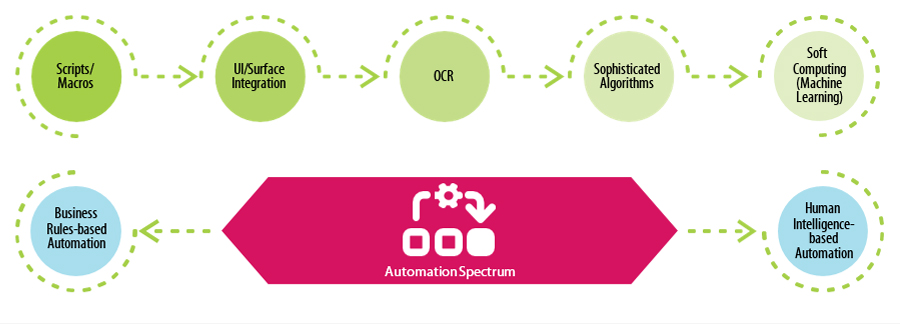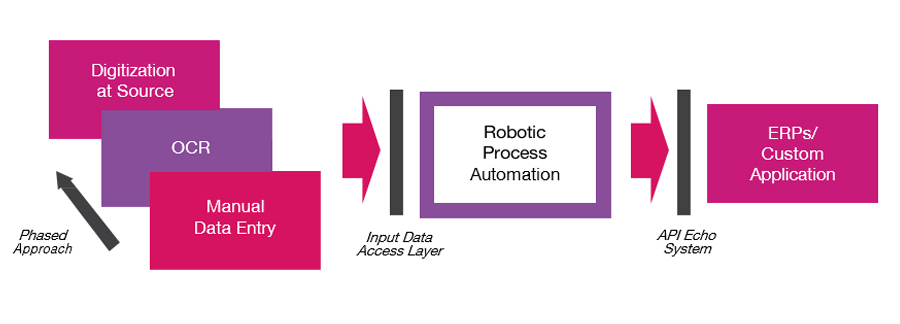Robotic Process Automation Spectrum – an Introduction
Automation is inevitable with the current cost pressures, demanding business requirements and huge IT legacies, to emerge as one of the key levers for expedition of the business transformation journey for many organizations.
Robotic Process Automation (RPA) can be defined as the technology layer which mimics the way humans interact with the system to execute business operations. The nature of business processes span from streamlined process with digital, structured data to unstructured data flowing in from images, scanned documents. Process steps also range from completely rule to human intelligence-based automation, supported by robust business process management and analytics platforms. Rule-based automation is primarily targeted towards processes which are driven by defined business rules. Structured text data processing through technologies like macros, user interface or surface integration, optical character recognition, etc. fall under this left side of the spectrum. Human intelligence-based automation is targeted towards knowledge-centric processes where the rules are a little fuzzy in nature and can’t be precisely defined.
The process typically requires the human brain to take decisions. Unstructured text data processing using sophisticated algorithms like neural network supported by core business domain knowledge repository fall under the right side of the spectrum.

RPA as a Catalyst to Your Strategy
RPA needs to be considered for the simple low-hanging processes with structured, digital inputs that involve rule based processing. By applying RPA, an organization can typically automate 15 to 20% of the processes which will yield around 10% efficiencies at organization level. Typically, RPA initiatives are driven by the business side of the organization with involvement of IT.
The second set of low hanging processes need to be redesigned to enable the process for automation. This needs strong understanding of the client business and lean/six-sigma techniques.
The fear of losing RPA’s early benefits in the overall long-term IT transformation strategy compels business leaders to hide their initiatives. Often, this results in a huge mushroom farm of robots, managed manually through localized teams. This in turn, multiplies hindrances to the pace of long-term IT strategy implementation and finally slows it down considerably. This is the time to change the mindset of CIOs and start evaluating RPA as a catalyst to their strategies.
Considering an enormous customer base, differences in their preferences of interaction styles and the very nature of business itself, ‘digitization at source’ might be a long-term strategy. However, RPA can effectively be designed with the right hooks to the source data and implemented in few months. To take a leapfrog to improve the operational efficiencies from 10% to 30%, an organization needs to embrace cognitive powered automation, which involves artificial intelligence-based algorithms that can make human like judgements, machine learning models which can understand the variances in the business inputs and map to the right model, natural language processing to decipher human like inputs and translate that to structured input for RPA processing.

Making the most of RPA - Aspects to consider
Platform credentials and future roadmap
The market has observed an exponential growth and evolution of RPA technologies in the last couple of years. Therefore, it becomes important to have a careful selection of RPA Platform apart from the company’s performance, credentials and product commercials. The other important consideration revolves around its current abilities and future roadmap.
Platform’s flexibility and collaboration features
A platform’s flexibility to integrate with different technologies and supporting enterprise-level centralized architecture to promote the virtual workforce concept in true sense, is the most important criteria to evaluate the current abilities.
Alignment of the product’s roadmap with emerging trends like Artificial Intelligence, business domain specific solutions and e2e business process management workbench, is another aspect to consider.
RPA Platform that provides better collaboration between the bot and human to get the operational work done will go long way. Features like work queue management, dynamic scheduling, human-in-loop are few such features to name.
Virtual vs. Manual effort
RPA is always implemented as a combination of virtual and manual workforce. However, the split is highly skewed towards virtual workforce. RPA is designed and capable of providing 100% accuracy for the processed transactions, but throughput varies from process to process. Typically, 10-20% effort is kept aside for the manual workforce to handle functional and technical exceptions. Return on investment is the most important aspect to be considered while designing the Robot. Many a time, the rule of 80-20 is applied to accomplish the maximum benefit. Low volume exceptions are typically kept out-of-scope for the Robots.
Change management
Effective change management is the key to success of any RPA implementation. This is also one of the major reasons for most of the failures in this space. There are primarily three set of possible changes – Process, IT infrastructure and Applications. These need to be thought through along
with the respective organizations - firstly, to align with their roadmaps and secondly, to carve out the right process
for change management.
If we look at the emerging trends in this space, most of the products are working towards increasing their breadth in the spectrum and thus focusing on building capabilities like Intelligent Automation, Optical Character Recognition.
Natural Language Processing, Virtual Assistance, Image and Video Analyzers, etc. Another group of products are primarily focusing towards business domain specific solutions and provide RPA as a service offering.



